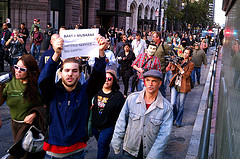As I was sitting on the San Francisco Bay Area’s subway line (BART) yesterday, an announcement came on to state that the Civic Center station, in the heart of downtown San Francisco, was closed and would remain so until further notice. My suspicions on what caused the closure were confirmed when I pulled out my smartphone to check the news: there were more people mobbing the station to protest about BART’s decision on August 11th to shut off cell phone service during earlier protests, which themselves were done to protest the shooting of Charles Hill on July 3rd by a police officer.
That I was able to check this on my phone also gave me confirmation that BART had not cut off cell phone coverage again. The disruption of cell phone service for the August 11th protests was the first in US history, and in the discussion that has ensued, the BART Board of Directors recognized that they had touched on freedom of speech issues. There was talk of having a “right to cell phone service.”
In none of the coverage so far, however, has there been talk about how unusual it is to have any cell phone coverage in a concrete tube several dozen feet underground while travelling 80 miles per hour. BART has only had it since 2004, when it was the first American system to introduce it. New York City, the largest and busiest subway in the United States, still has no service underground.
The BART case follows on the heels of the Arab Spring, where governments fell across the Arab world in uprisings that often were heavily coordinated by social networks and cell phones, which in turn were sometimes taken down by the government. The decision to disrupt service by a local government authority in the United States should spark a debate about when such action is acceptable. This is an example of how a modification in our technological landscape is also a modification in our social landscape. As cell phone coverage came online, there was new space in which social interactions were shaped, e.g. was it ok to have phone conversations on the BART? When the service was cut, still more space opened up for debate, e.g. when was it just for a government to suspend a communication service within a public, government-owned facility? The decision to deploy, as well as restrict, public cell phone service is a sociotechnical decision, and in a democratic society, that should mean that members of the public have a say. That can be after an event like this happens, or in the case of recent British decisions, before the government decides to close off a communication system.
Samuel Evans is Editor of Vignettes@STS.Next.20. He is also an Associate Research Fellow in the Harvard STS Program, and a Visiting Scholar at the University of California, Berkeley.






